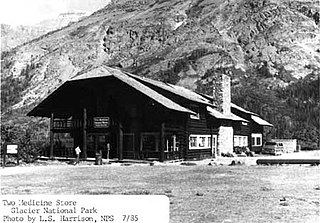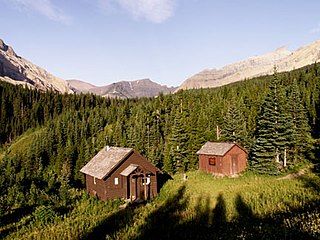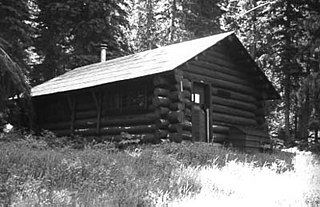
Two Medicine Store, formerly part of Two Medicine Chalets, is a historic building in Glacier National Park in the U.S. state of Montana. The chalet was originally built in 1914 by the Glacier Park Hotel Company, a subsidiary of the Great Northern Railway, as part of the railway's extensive program of visitor services development at Glacier. The chalet group originally featured a complex of log buildings, all built in the rustic style, which provided dining and lodging facilities. Overnight accommodations at the chalet ended with the onset of World War II, and the other buildings at the site were intentionally burned in 1956.

The Rising Sun Auto Camp, also known as the Roes Creek Auto Camp, East Glacier Auto Camp or simply Rising Sun preserves a portion of the built-up area of Glacier National Park that documents the second phase of tourist development in the park. Rising Sun is located along the Going-to-the-Sun Road, approximately 7 miles (11 km) from the east entrance to Glacier National Park, Montana, United States. Rising Sun is a wayside area that has a National Park Service campground, a camp store and gift shop, picnic area, restaurant, as well as a motel and guest cabins which are managed by the park's concessionaire, Xanterra Parks & Resorts. In the immediate area, there is also a boat dock as well as sightseeing boats which allow visitors to tour Saint Mary Lake, the second largest lake in the park. "The most popular spot for [Glacier] tourists is Rising Sun, an overlook of Goose Island in St. Mary Lake and one of the most photographed spots in the park."

The Logging Creek Ranger Station is the oldest continually operating administrative site in Glacier National Park. The rustic log cabin is an early example of what would become a typical style of western park structure. The district includes a cabin used as a residence for the summer fire guard.

The Roes Creek Campground Camptender's Cabin, also known as the Rising Sun Campground Ranger Cabin, in Glacier National Park is an example of the National Park Service Rustic style.

The Many Glacier Campground Camptender's Cabin in Glacier National Park is an example of the National Park Service Rustic style. Built in 1934, the small cabin is significant for its association with park visitation patterns, auto camping, and NPS rustic architecture.

The Many Glacier Barn and Bunkhouse in Glacier National Park, also known as Packer's Roost East, were constructed to serve backcountry pack trail activities near the Many Glacier Hotel. The barn was designed in 1938 by the National Park Service Branch of Plans and Design to replace a barn that had burned in the Swiftcurrent Valley fire of 1936, using a simplified form of the National Park Service Rustic style. The bunkhouse was built nearby, then moved directly adjacent to the barn.

The Swiftcurrent Auto Camp Historic District preserves a portion of the built-up area of Glacier National Park that documents the second phase of tourist development in the park. After the creation of a series of hotels for train-borne visitors including the nearby Many Glacier Hotel, courtesy of the Great Northern Railway's hotel concession, facilities were developed for the increasing numbers of automobile-borne tourists, drawn to Glacier by the Going-to-the-Sun Road. The Swiftcurrent Auto Camp at Swiftcurrent Lake was created for these new tourists. It includes a rustic general store, built in 1935 by the Glacier Park Hotel Company, surrounded by a number of log tourist cabins., as well as a shower and laundry house and other supporting structures.

The Swanson Boathouse, also known as the Two Medicine Boathouse, was built in 1936 by concessioner Billy Swanson at Two Medicine Lake in Glacier National Park. The rustic structure remains in its intended use. The boathouse was built by Captain J.W. "Billy" Swanson, who operated a launch on Two Medicine Lake.

The Glacier National Park Tourist Trails, including the Inside Trail, South Circle Trail and North Circle Trail, were established in Glacier National Park to connect a series of tourist camps and hotels established by the Great Northern Railway between 1910 and 1915. Prior to the construction of the Going-to-the-Sun Road, these trails were the primary form of circulation within the park. The trail system includes a number of bridges.

The Lower Nyack Snowshoe Cabin, built in 1927 in Glacier National Park, is a significant resource both architecturally and historically as a shelter about one day's travel north of the Theodore Roosevelt Highway for patrolling backcountry rangers. The design originated at Yellowstone National Park, adapted in this case with a somewhat larger size.

The Lower Logging Lake Snowshoe Cabin and Boathouse were built in 1933 in Glacier National Park near the southwestern end of Logging Lake. The National Park Service Rustic boathouse stores rangers' canoes for patrolling the lake and their journeys between Upper and Lower Logging Lake patrol cabins. The Lower Logging Lake snowshoe cabin is nearby. They are a significant resources both architecturally and historically, constructed for backcountry patrols.

The Ford Creek Patrol Cabin in Glacier National Park was built in 1928. The National Park Service Rustic log structure was a significant resource both architecturally and historically as a network of shelters, approx. one day's travel apart, for patrolling backcountry rangers.

The Bowman Lake Patrol Cabin in Glacier National Park, Montana, United States, is a rustic back-country log cabin. Built in 1934, the cabin has a single room, with a front porch extension to create a shelter from snowfall.

The Lower Park Creek Patrol Cabin in Glacier National Park is a rustic backcountry log cabin. Built in 1925, the cabin has a single room. The design originated at Yellowstone National Park.

The Upper Park Creek Patrol Cabin in Glacier National Park is a rustic backcountry log cabin. Built in 1928, the cabin has a single room. The cabin was built to National Park Service design G913, and adaptation of cabins used at Yellowstone National Park, which had been modeled on those used by the U.S. Forest Service, which in turn were derivations of backwoods trappers' cabins. The Upper Park Creek cabin was more difficult than most to construct, due to its high, remote location.

The Slide Lake-Otatso Creek Patrol Cabin and Woodshed in Glacier National Park are a small group of rustic buildings in the park's backcountry. Built in 1936, the patrol cabin is a frame building, unlike the more typical log patrol cabins found throughout the park. The similar woodshed is nearby. The cabin's proximity to the Alpine-themed Many Glacier Hotel may have influenced the decorative detailing, which is unique in Glacier. The only other frame patrol cabin is the Fielding Cabin, in the southern part of the park. The cabin was completely reconstructed in the 1980s "to thwart a particularly aggressive pack rat population". The buildings are located along Otatso Creek, 1.25 miles (2.01 km) downstream from Slide Lake.

The McCarthy Homestead Cabin is a remnant of early settlement in what would become Glacier National Park. Jeremiah McCarthy built the log homestead in the North Fork area in 1908 after completion of the North Fork Road and passage of the Forest Homestead Act of 1906. Building the cabin was part of beginning to prove up a 130 acres (53 ha) homestead. Jeremiah died of consumption in May 1909, but his wife Margaret and eldest child continued the homesteading process by tilling a required amount of land in 1909. And with further improvements each year a "Final Proof" certificate was earned in 1913. Meanwhile, in 1910 the property was included within the area of the new Glacier National Park; it became a private inholding. Margaret McCarthy died in 1939 but children and grandchildren kept spending summers here. In 1970 it was bought by the National Park Service.

The Logan Creek Patrol Cabin in Glacier National Park is a rustic backcountry log cabin. Built in 1925, the cabin has a single room. It is unusual among Glacier's patrol cabins in lacking a covered porch to offer sheltered firewood storage and protection for the entrance.

The Glacier Basin Campground Ranger Station in Rocky Mountain National Park was built in 1930 to a design by the National Park Service Branch of Plans and Designs. The National Park Service Rustic log and stone structure was designed to blend with the landscape, and continues to function as a ranger station.
Architects of the National Park Service are the architects and landscape architects who were employed by the National Park Service (NPS) starting in 1918 to design buildings, structures, roads, trails and other features in the United States National Parks. Many of their works are listed on the National Register of Historic Places, and a number have also been designated as National Historic Landmarks.






















